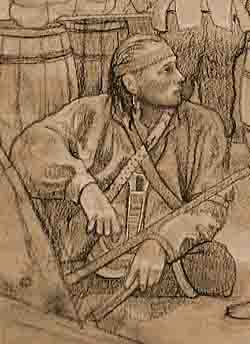first peoples
Overview
Throughout the Connecticut River Valley lived numerous native groups, including the Agawams, Nonotucks, and other Pocumtuck peoples. The cultures of these groups varied somewhat in terms of their means of subsistence, uses of local flora and fauna, the kinds of tools available and their settlement patterns. However, the majority of these groups shared similar languages and cultures, known as Eastern Algonquian, and were further connected through political alliances and kinship.
Native culture in the Valley was constantly in flux. Interaction among the groups was marked by both cooperation and conflict. Warfare was common with the Pequot to the south and the Iroquois to the north. Contact with traders, settlers, and the European-born diseases they carried altered traditional social and economic patterns. The introduction of European settlements, trading goods, farm animals, agricultural techniques, iron tools, styles of dress, and religious practices altered not only the landscape but the First Peoples' cultures forever.
